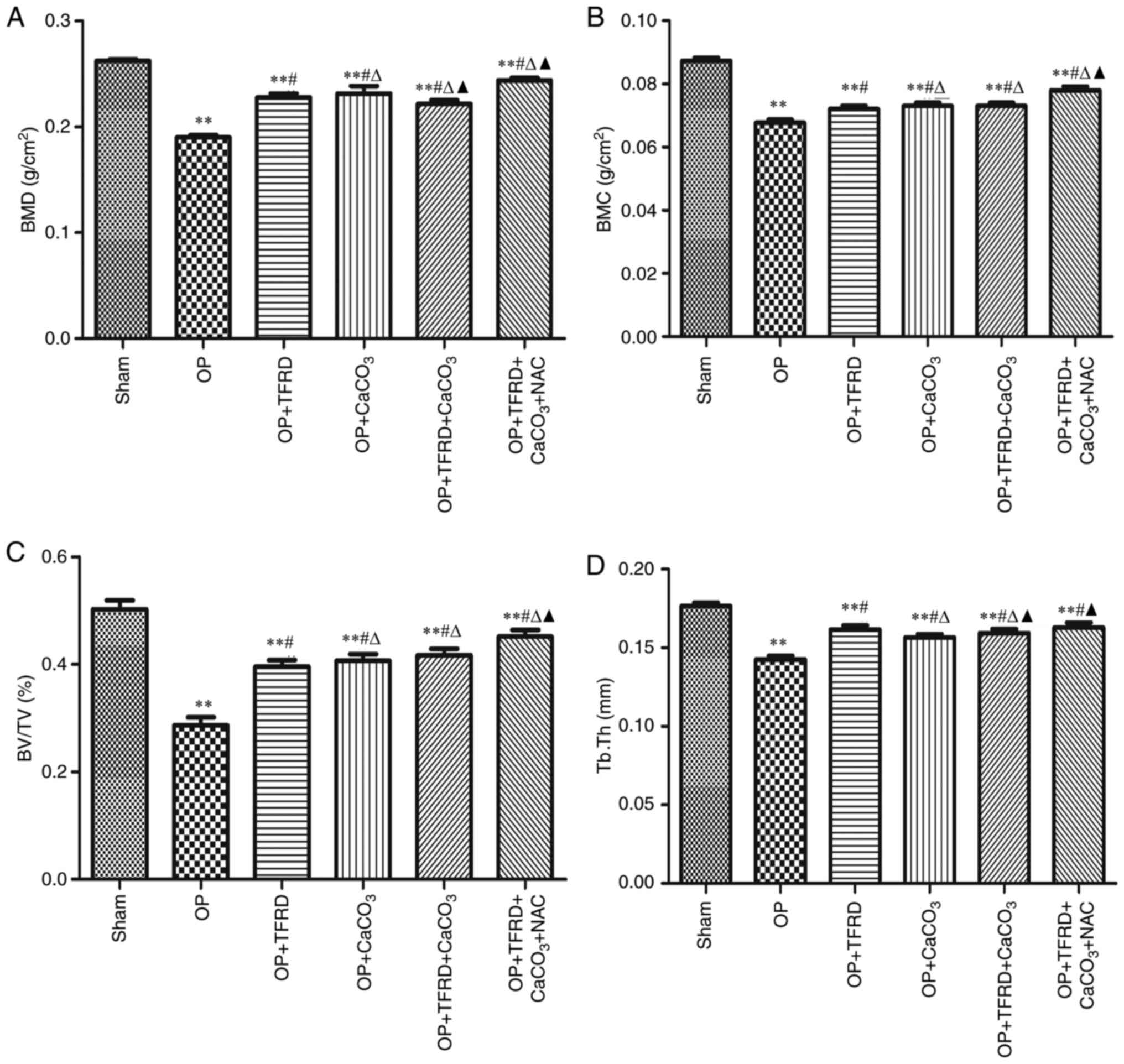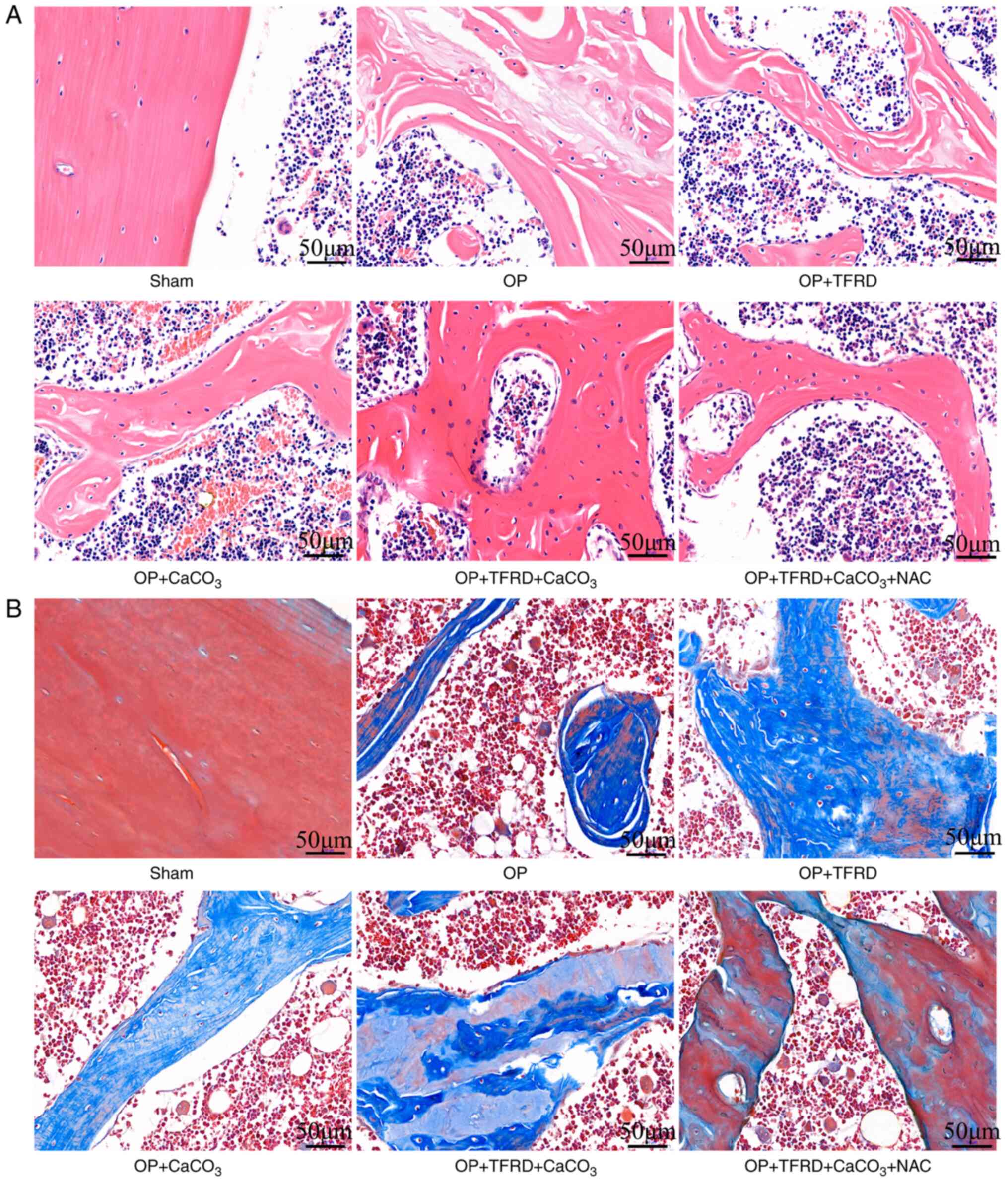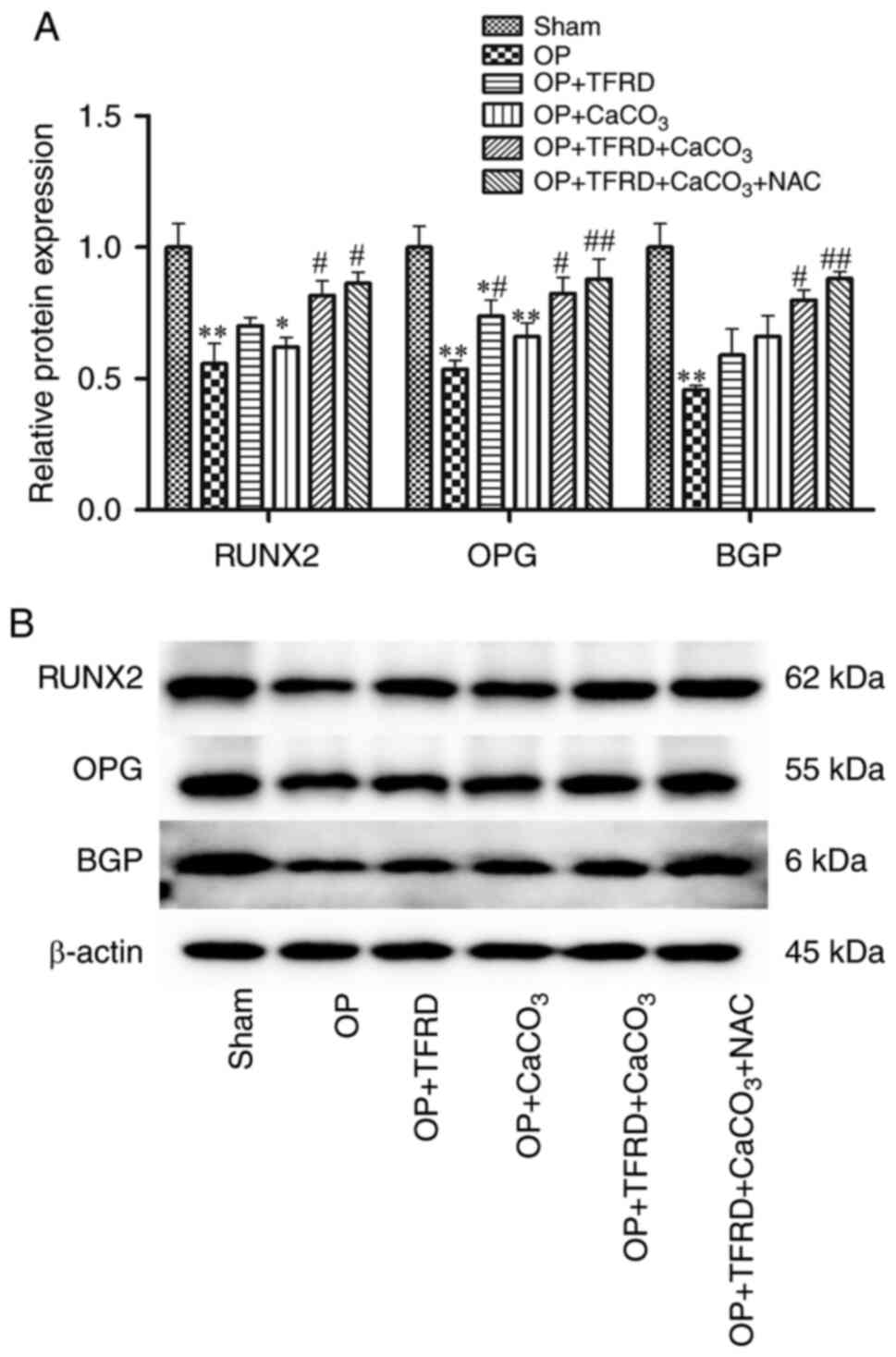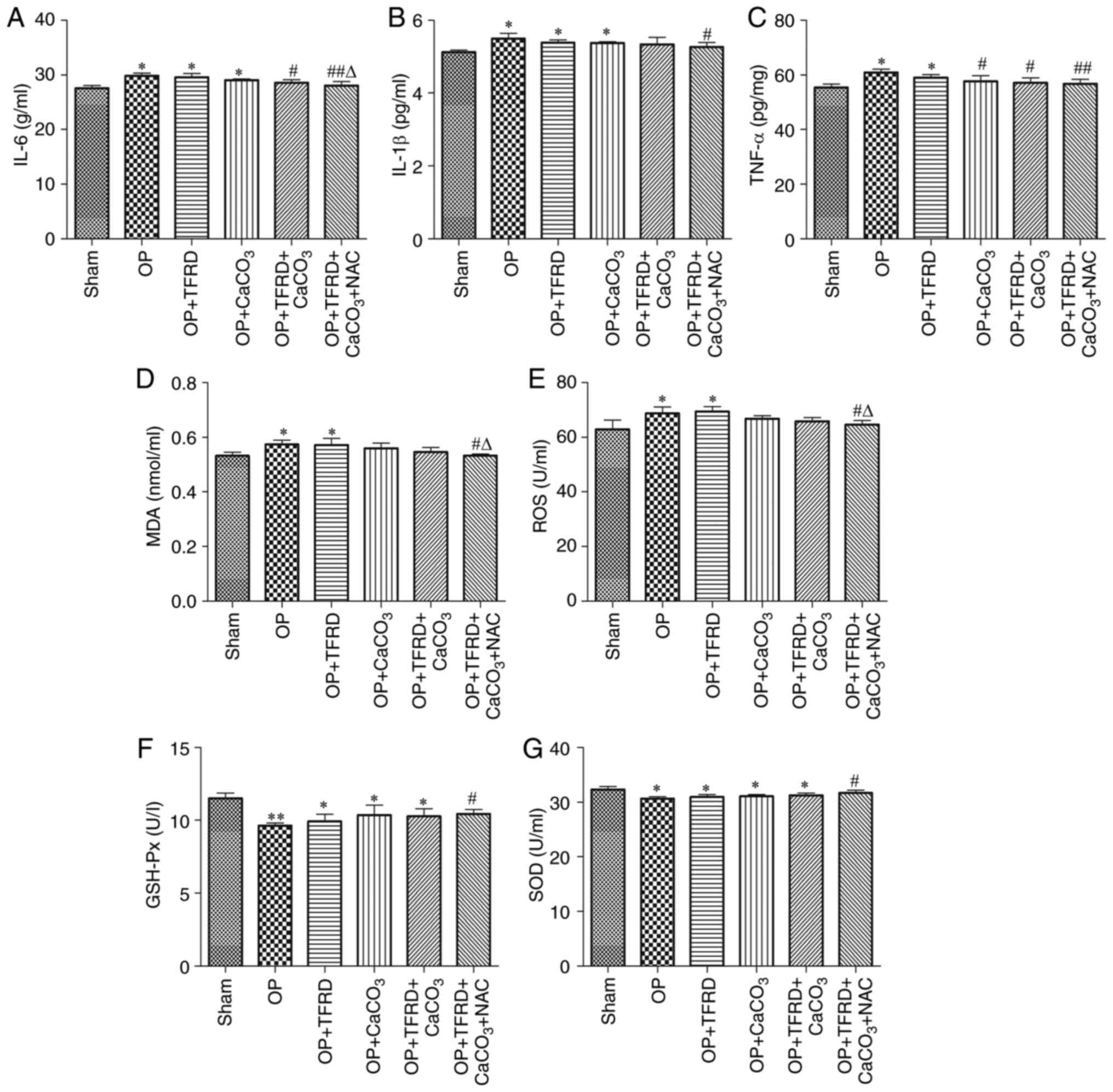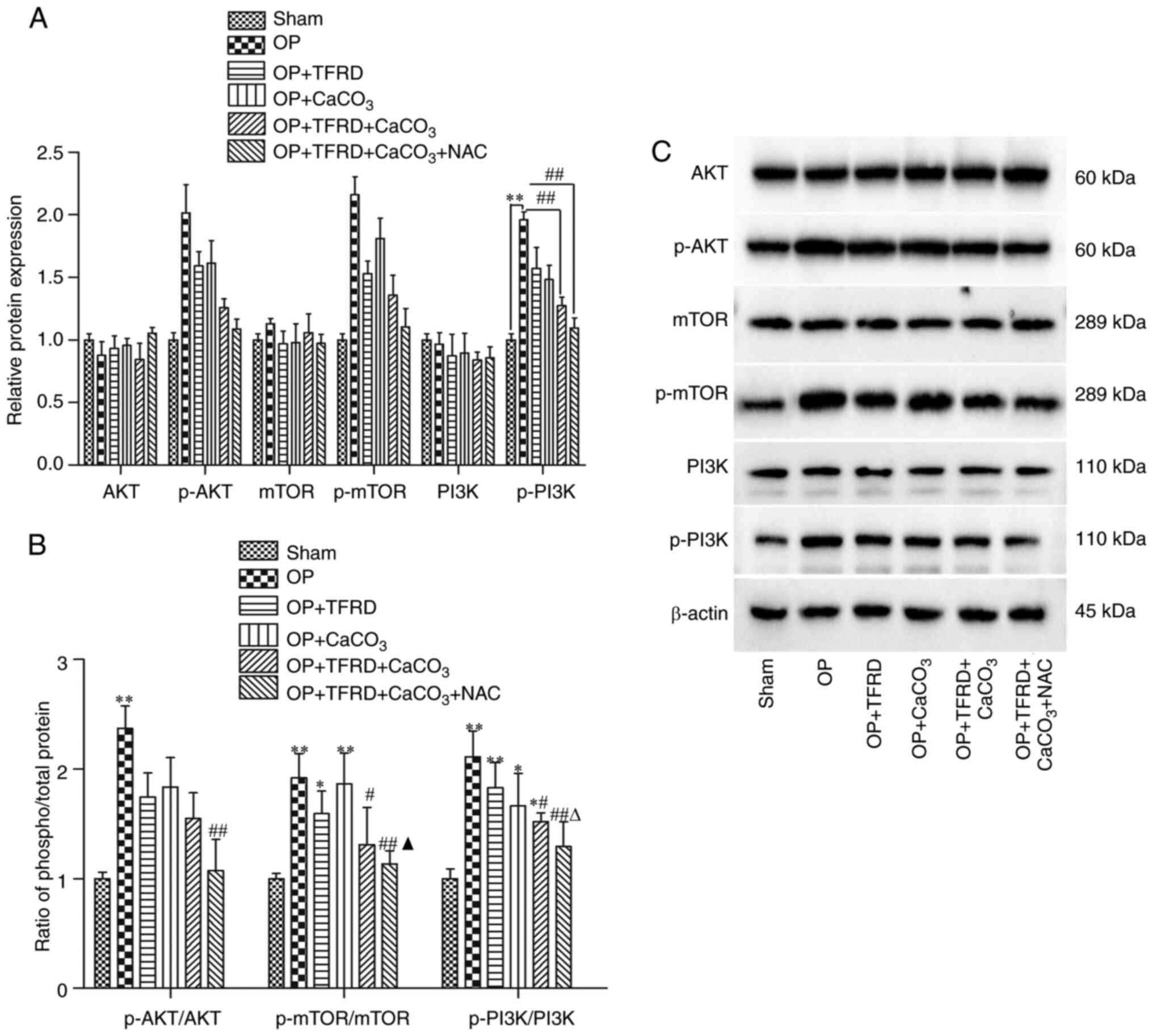|
1
|
Raisz LG: Pathogenesis of osteoporosis:
Concepts, conflicts, and prospects. J Clin Invest. 115:3318–3325.
2005.PubMed/NCBI View
Article : Google Scholar
|
|
2
|
Cano A, Chedraui P, Goulis DG, Lopes P,
Mishra G, Mueck A, Senturk LM, Simoncini T, Stevenson JC, Stute P,
et al: Calcium in the prevention of postmenopausal osteoporosis:
EMAS clinical guide. Maturitas. 107:7–12. 2018.PubMed/NCBI View Article : Google Scholar
|
|
3
|
Bonaccorsi G, Piva I, Greco P and
Cervellati C: Oxidative stress as a possible pathogenic cofactor of
post-menopausal osteoporosis: Existing evidence in support of the
axis oestrogen deficiency-redox imbalance-bone loss. Indian J Med
Res. 147:341–351. 2018.PubMed/NCBI View Article : Google Scholar
|
|
4
|
Zeng Q, Li N, Wang Q, Feng J, Sun D, Zhang
Q, Huang J, Wen Q, Hu R, Wang L, et al: The Prevalence of
Osteoporosis in China, a Nationwide, Multicenter DXA Survey. J Bone
Miner Res. 34:1789–1797. 2019.PubMed/NCBI View Article : Google Scholar
|
|
5
|
Omsland TK and Magnus JH: Forecasting the
burden of future postmenopausal hip fractures. Osteoporos Int.
25:2493–2496. 2014.PubMed/NCBI View Article : Google Scholar
|
|
6
|
Manolagas SC: From estrogen-centric to
aging and oxidative stress: A revised perspective of the
pathogenesis of osteoporosis. Endocr Rev. 31:266–300.
2010.PubMed/NCBI View Article : Google Scholar
|
|
7
|
Wang J, Wang G, Gong L, Sun G, Shi B, Bao
H and Duan Y: Isopsoralen regulates PPAR γ/WNT to inhibit oxidative
stress in osteoporosis. Mol Med Rep. 17:1125–1131. 2018.PubMed/NCBI View Article : Google Scholar
|
|
8
|
An J, Yang H, Zhang Q, Liu C, Zhao J,
Zhang L and Chen B: Natural products for treatment of osteoporosis:
The effects and mechanisms on promoting osteoblast-mediated bone
formation. Life Sci. 147:46–58. 2016.PubMed/NCBI View Article : Google Scholar
|
|
9
|
Shieh P, Jan CR and Liang WZ: The
protective effects of the antioxidant N-acetylcysteine (NAC)
against oxidative stress-associated apoptosis evoked by the
organophosphorus insecticide malathion in normal human astrocytes.
Toxicology. 417:1–14. 2019.PubMed/NCBI View Article : Google Scholar
|
|
10
|
Chen L, Wang G, Wang Q, Liu Q, Sun Q and
Chen L: N-acetylcysteine prevents orchiectomy-induced osteoporosis
by inhibiting oxidative stress and osteocyte senescence. Am J
Transl Res. 11:4337–4347. 2019.PubMed/NCBI
|
|
11
|
Raffaele M, Barbagallo I, Licari M, Carota
G, Sferrazzo G, Spampinato M, Sorrenti V and Vanella L:
N-Acetylcysteine (NAC) ameliorates lipid-related metabolic
dysfunction in bone marrow stromal cells-derived adipocytes. Evid
Based Complement Alternat Med. 2018(5310961)2018.PubMed/NCBI View Article : Google Scholar
|
|
12
|
Matera MG, Calzetta L and Cazzola M:
Oxidation pathway and exacerbations in COPD: The role of NAC.
Expert Rev Respir Med. 10:89–97. 2016.PubMed/NCBI View Article : Google Scholar
|
|
13
|
Dludla PV, Dias SC, Obonye N, Johnson R,
Louw J and Nkambule BB: A Systematic Review on the Protective
Effect of N-Acetyl Cysteine Against Diabetes-Associated
Cardiovascular Complications. American journal of cardiovascular
drugs: drugs, devices, and other interventions. 18:283–298.
2018.PubMed/NCBI View Article : Google Scholar
|
|
14
|
Yamada M, Tsukimura N, Ikeda T, Sugita Y,
Att W, Kojima N, Kubo K, Ueno T, Sakurai K and Ogawa T: N-acetyl
cysteine as an osteogenesis-enhancing molecule for bone
regeneration. Biomaterials. 34:6147–6156. 2013.PubMed/NCBI View Article : Google Scholar
|
|
15
|
Sheweita SA and Khoshhal KI: Calcium
metabolism and oxidative stress in bone fractures: Role of
antioxidants. Curr Drug Metab. 8:519–525. 2007.PubMed/NCBI View Article : Google Scholar
|
|
16
|
Zhou RP, Lin SJ, Wan WB, Zuo HL, Yao FF,
Ruan HB, Xu J, Song W, Zhou YC, Wen SY, et al: Chlorogenic Acid
Prevents Osteoporosis by Shp2/PI3K/Akt Pathway in Ovariectomized
Rats. PLoS One. 11(e0166751)2016.PubMed/NCBI View Article : Google Scholar
|
|
17
|
Xi JC, Zang HY, Guo LX, Xue HB, Liu XD,
Bai YB and Ma YZ: The PI3K/AKT cell signaling pathway is involved
in regulation of osteoporosis. J Recept Signal Transduct Res.
35:640–645. 2015.PubMed/NCBI View Article : Google Scholar
|
|
18
|
Yuan FL, Xu RS, Jiang DL, He XL, Su Q, Jin
C and Li X: Leonurine hydrochloride inhibits osteoclastogenesis and
prevents osteoporosis associated with estrogen deficiency by
inhibiting the NF-κB and PI3K/Akt signaling pathways. Bone.
75:128–137. 2015.PubMed/NCBI View Article : Google Scholar
|
|
19
|
Wang H, Zhao W, Tian QJ, Xin L, Cui M and
Li YK: Effect of lncRNA AK023948 on rats with postmenopausal
osteoporosis via PI3K/AKT signaling pathway. Eur Rev Med Pharmacol
Sci. 24:2181–2188. 2020.PubMed/NCBI View Article : Google Scholar
|
|
20
|
Song S, Gao Z, Lei X, Niu Y, Zhang Y, Li
C, Lu Y, Wang Z and Shang P: Total flavonoids of Drynariae
Rhizoma prevent bone loss induced by Hindlimb unloading in
rats. Molecules. 22(22)2017.PubMed/NCBI View Article : Google Scholar
|
|
21
|
Fang J, Yang L, Shen JZ, et al: Effects of
total flavonoids of Rhizoma Drynariae on glutamate signal
Glu, mGluR5 and EAAT1 in bone of ovariectomized rats. Chin J
Biochem Drugs. 34:10–12,16. 2014.
|
|
22
|
Zhu F, Liu Z and Ren Y: Mechanism of
melatonin combined with calcium carbonate on improving osteoporosis
in aged rats. Exp Ther Med. 16:192–196. 2018.PubMed/NCBI View Article : Google Scholar
|
|
23
|
Ensrud KE and Crandall CJ: Osteoporosis.
Ann Intern Med. 167:ITC17–ITC32. 2017.PubMed/NCBI View Article : Google Scholar
|
|
24
|
Bidwell JP, Alvarez MB, Hood M Jr and
Childress P: Functional impairment of bone formation in the
pathogenesis of osteoporosis: The bone marrow regenerative
competence. Curr Osteoporos Rep. 11:117–125. 2013.PubMed/NCBI View Article : Google Scholar
|
|
25
|
Weaver CM, Alexander DD, Boushey CJ,
Dawson-Hughes B, Lappe JM, LeBoff MS, Liu S, Looker AC, Wallace TC
and Wang DD: Calcium plus vitamin D supplementation and risk of
fractures: an updated meta-analysis from the National Osteoporosis
Foundation. Osteoporos Int. 27:367–376. 2016.PubMed/NCBI View Article : Google Scholar
|
|
26
|
Shuid AN, Mohamad S, Mohamed N, Fadzilah
FM, Mokhtar SA, Abdullah S, Othman F, Suhaimi F, Muhammad N and
Soelaiman IN: Effects of calcium supplements on fracture healing in
a rat osteoporotic model. Orthop Res. 28:1651–1656. 2010.PubMed/NCBI View Article : Google Scholar
|
|
27
|
Paschalis EP, Gamsjaeger S, Hassler N,
Fahrleitner-Pammer A, Dobnig H, Stepan JJ, Pavo I, Eriksen EF and
Klaushofer K: Vitamin D and calcium supplementation for three years
in postmenopausal osteoporosis significantly alters bone mineral
and organic matrix quality. Bone. 95:41–46. 2017.PubMed/NCBI View Article : Google Scholar
|
|
28
|
Zhang F, Xie J, Wang G, Zhang G and Yang
H: Anti-osteoporosis activity of Sanguinarine in preosteoblast
MC3T3-E1 cells and an ovariectomized rat model. J Cell Physiol.
233:4626–4633. 2018.PubMed/NCBI View Article : Google Scholar
|
|
29
|
Cervellati C, Bonaccorsi G, Cremonini E,
Bergamini CM, Patella A, Castaldini C, Ferrazzini S, Capatti A,
Picarelli V, Pansini FS, et al: Bone mass density selectively
correlates with serum markers of oxidative damage in
post-menopausal women. Clin Chem Lab Med. 51:333–338.
2013.PubMed/NCBI View Article : Google Scholar
|
|
30
|
Cervellati C and Bergamini CM: Oxidative
damage and the pathogenesis of menopause related disturbances and
diseases. Clin Chem Lab Med. 54:739–753. 2016.PubMed/NCBI View Article : Google Scholar
|
|
31
|
Wu X, Li J, Zhang H, Wang H, Yin G and
Miao D: Pyrroloquinoline quinone prevents testosterone
deficiency-induced osteoporosis by stimulating osteoblastic bone
formation and inhibiting osteoclastic bone resorption. Am J Transl
Res. 9:1230–1242. 2017.PubMed/NCBI
|
|
32
|
Orchard T, Yildiz V, Steck SE, Hébert JR,
Ma Y, Cauley JA, Li W, Mossavar-Rahmani Y, Johnson KC, Sattari M,
et al: Dietary inflammatory index, bone mineral density, and risk
of fracture in postmenopausal women: Results from the Women's
Health Initiative. J Bone Miner Res. 32:1136–1146. 2017.PubMed/NCBI View Article : Google Scholar
|
|
33
|
Chen B and Li HZ: Association of IL-6
174G/C (rs1800795) and 572C/G (rs1800796) polymorphisms with risk
of osteoporosis: A meta-analysis. BMC Musculoskelet Disord.
21(330)2020.PubMed/NCBI View Article : Google Scholar
|
|
34
|
Al-Daghri NM, Aziz I, Yakout S, Aljohani
NJ, Al-Saleh Y, Amer OE, Sheshah E, Younis GZ and Al-Badr FBM:
Inflammation as a contributing factor among postmenopausal Saudi
women with osteoporosis. Medicine (Baltimore).
96(e5780)2017.PubMed/NCBI View Article : Google Scholar
|
|
35
|
Wang Q, Li Y and Zhang Y, Ma L, Lin L,
Meng J, Jiang L, Wang L, Zhou P and Zhang Y: lncRNA MEG3 inhibited
osteogenic differentiation of bone marrow mesenchymal stem cells
from postmenopausal osteoporosis by targeting miR-133a-3p. Biomed
Pharmacother. 89:1178–1186. 2017.PubMed/NCBI View Article : Google Scholar
|
|
36
|
Zhu W, He X, Hua Y, Li Q, Wang J and Gan
X: The E3 ubiquitin ligase WWP2 facilitates RUNX2 protein
transactivation in a mono-ubiquitination manner during osteogenic
differentiation. J Biol Chem. 292:11178–11188. 2017.PubMed/NCBI View Article : Google Scholar
|
|
37
|
Zhu XB, Lin WJ, Lv C, Wang L, Huang ZX,
Yang SW and Chen X: MicroRNA-539 promotes osteoblast proliferation
and differentiation and osteoclast apoptosis through the
AXNA-dependent Wnt signaling pathway in osteoporotic rats. J Cell
Biochem. 119:8346–8358. 2018.PubMed/NCBI View Article : Google Scholar
|
|
38
|
Dufresne SS, Dumont NA, Bouchard P,
Lavergne É, Penninger JM and Frenette J: Osteoprotegerin protects
against muscular dystrophy. Am J Pathol. 185:920–926.
2015.PubMed/NCBI View Article : Google Scholar
|
|
39
|
Wolski H, Drews K, Bogacz A, Kamiński A,
Barlik M, Bartkowiak-Wieczorek J, Klejewski A, Ożarowski M,
Majchrzycki M and Seremak-Mrozikiewicz A: The RANKL/RANK/OPG signal
trail: Significance of genetic polymorphisms in the etiology of
postmenopausal osteoporosis. Ginekol Pol. 87:347–352.
2016.PubMed/NCBI View Article : Google Scholar
|
|
40
|
Mukherjee A and Rotwein P: Selective
signaling by Akt1 controls osteoblast differentiation and
osteoblast-mediated osteoclast development. Mol Cell Biol.
32:490–500. 2012.PubMed/NCBI View Article : Google Scholar
|
|
41
|
Ouyang N, Zhang P, Fu R, Shen G, Jiang L
and Fang B: Mechanical strain promotes osteogenic differentiation
of bone mesenchymal stem cells from ovariectomized rats via the
phosphoinositide 3 kinase/Akt signaling pathway. Mol Med Rep.
17:1855–1862. 2018.PubMed/NCBI View Article : Google Scholar
|
|
42
|
Kita K, Kimura T, Nakamura N, Yoshikawa H
and Nakano T: PI3K/Akt signaling as a key regulatory pathway for
chondrocyte terminal differentiation. Genes to cells: Devoted to
molecular & cellular mechanisms. 13:839–850. 2008.PubMed/NCBI View Article : Google Scholar
|
|
43
|
Li M, Luo R, Yang W, Zhou Z and Li C:
miR-363-3p is activated by MYB and regulates osteoporosis
pathogenesis via PTEN/PI3K/AKT signaling pathway. In Vitro Cell Dev
Biol Anim. 55:376–386. 2019.PubMed/NCBI View Article : Google Scholar
|
|
44
|
Zhang Y, Cao X, Li P, Fan Y, Zhang L, Li W
and Liu Y: PSMC6 promotes osteoblast apoptosis through inhibiting
PI3K/AKT signaling pathway activation in ovariectomy-induced
osteoporosis mouse model. J Cell Physiol. 235:5511–5524.
2020.PubMed/NCBI View Article : Google Scholar
|















